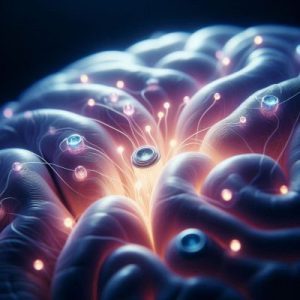You can activate hidden neural circuits in your brain by targeting specific neurotransmitters like serotonin and dopamine to improve mood and focus. Techniques such as mindfulness and creative visualization modulate brain chemistry, enhancing cognitive flexibility and emotional regulation. Additionally, emerging technologies like neural implants and brainwave entrainment offer precise control over neural pathways to boost mental performance. These methods tap into your brain’s plasticity and circuitry, reveal potential you can harness with the right strategies ahead.
Understanding Neural Pathways and Their Functions
 Although neural pathways consist of complex networks, you can understand them as the communication highways that transmit signals between different parts of the nervous system. These pathways are dynamic, shaped continuously by neural plasticity—the brain’s ability to reorganize connections in response to experience or injury.
Although neural pathways consist of complex networks, you can understand them as the communication highways that transmit signals between different parts of the nervous system. These pathways are dynamic, shaped continuously by neural plasticity—the brain’s ability to reorganize connections in response to experience or injury.
Through synaptic pruning, your brain eliminates weaker synaptic contacts while strengthening essential ones, optimizing signal transmission efficiency. This selective refinement enhances cognitive function by reinforcing frequently used pathways and discarding redundant ones.
When you engage in learning or adaptation, neural plasticity modifies these pathways structurally and functionally. Understanding this process helps you appreciate how your brain maintains flexibility and precision in processing information, making neural pathways fundamental to your sensory input, motor control, and higher cognitive tasks.
The Role of Neurotransmitters in Mood Regulation
Neural pathways rely on chemical messengers called neurotransmitters to transmit signals across synapses, directly influencing how your brain processes information and responds to stimuli. When it comes to mood regulation, neurotransmitters like serotonin and dopamine play critical roles.
You can understand their influence through these key points:
- Serotonin balance stabilizes mood, anxiety, and happiness by modulating synaptic transmission.
- Dopamine pathways regulate reward processing, motivation, and pleasure sensations.
- Disruptions in these neurotransmitter systems correlate with mood disorders such as depression and bipolar disorder.
- Targeting neurotransmitter activity pharmacologically or through lifestyle changes can restore equilibrium and improve emotional regulation.
Techniques to Enhance Cognitive Function
Since cognitive function underpins all mental processes, enhancing it requires targeted techniques that optimize brain efficiency and adaptability. You can employ mindfulness meditation to sharpen your attention and improve working memory by reducing cognitive interference. This practice enhances prefrontal cortex activity, promoting executive function.
Additionally, creative visualization activates neural circuits involved in problem-solving and planning, reinforcing synaptic connections and fostering neuroplasticity. When you systematically engage in these methods, you stimulate both hemispheres, increasing mental flexibility and information processing speed.
Integrating mindfulness meditation with creative visualization creates synergistic effects, as mindfulness stabilizes focus while visualization amplifies cognitive rehearsal. By consistently applying these techniques, you effectively press the brain’s hidden buttons that modulate learning capacity and cognitive resilience, thereby elevating your overall mental performance.
Mindfulness and Its Impact on Brain Chemistry
Building on how mindfulness meditation sharpens attention and executive function, it’s important to examine how this practice alters brain chemistry to produce those cognitive benefits. When you engage in mindfulness, you activate neural plasticity, which enhances your brain’s ability to rewire itself.
Specifically, mindfulness:
- Increases gamma-aminobutyric acid (GABA) levels, reducing anxiety and promoting calm.
- Boosts serotonin production, improving mood and emotional regulation.
- Enhances dopamine release, sharpening focus and motivation.
- Modulates cortisol, lowering stress and protecting brain structures involved in memory.
These chemical shifts reinforce neural circuits that support emotional regulation and cognitive flexibility.
Using Technology to Stimulate Brain Activity
Although traditional methods like mindfulness have proven effective, leveraging technology offers precise ways to stimulate brain activity and enhance cognitive function. You can utilize neural implants to directly interface with specific brain regions, modulating neural circuits with millisecond accuracy. These implants facilitate targeted stimulation, enabling enhanced memory, attention, or motor control by electrically activating or inhibiting neurons.
Additionally, brainwave entrainment employs external rhythmic stimuli—such as auditory or visual pulses—to synchronize your brainwaves to desired frequencies. This synchronization can optimize states like focus or relaxation by aligning neural oscillations with the entrainment pattern.
Both approaches rely on precise modulation of neural activity, allowing you to tap into hidden brain buttons with unprecedented control. By integrating these technologies, you harness a new frontier in cognitive enhancement, transcending traditional boundaries.
Habits That Promote Mental Resilience and Creativity
How do you cultivate mental resilience and spark creativity amid cognitive challenges? You engage specific habits that activate memory triggers and emotional triggers, optimizing brain function. Consider these key strategies:
- Structured Reflection: Regularly analyze experiences to reinforce memory triggers, consolidating learning and adaptability.
- Emotional Regulation Practices: Employ techniques like mindfulness to modulate emotional triggers, enhancing cognitive flexibility.
- Diverse Problem-Solving: Challenge your brain with novel tasks, promoting neural plasticity and creative pathways.
- Consistent Physical Activity: Stimulate neurogenesis and improve mood, indirectly supporting memory and emotional processing.
Conclusion
If you don’t start pressing these hidden brain buttons now, you might as well resign yourself to mental stagnation—your neurons begging for stimulation, your cognitive potential trapped in endless dormancy. By understanding neural pathways, harnessing neurotransmitters, and applying precise techniques, you can literally rewire your mind for peak performance. Ignoring these strategies means missing out on accessing the full, explosive power of your brain’s untapped capabilities. Don’t let your neural edge slip away.








